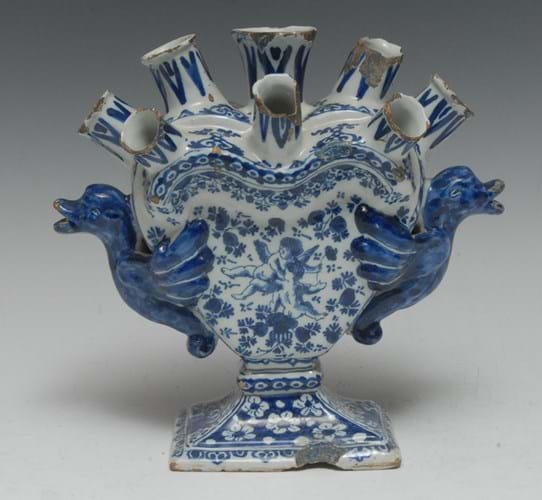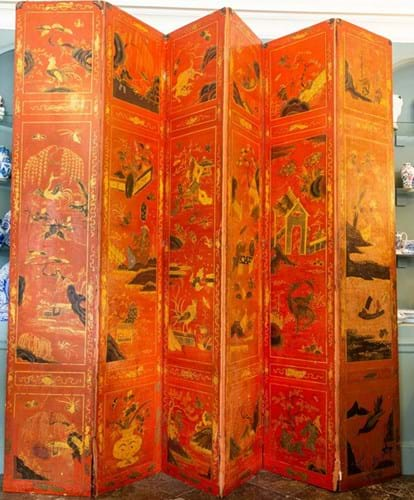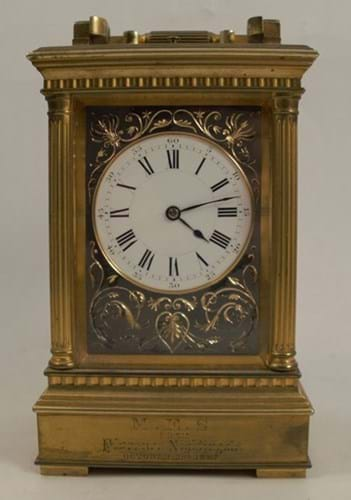1. Chinese porcelain saucer dish – £7850
Estimated at just £50-70, this Chinese porcelain saucer dish sold for £7850 at Edinburgh saleroom Franklin Brown. Although only tersely catalogued it almost certainly dates from the Kangxi period (1661-1722) – an era when the imperial porcelain factories at Jingdezhen, inactive during the upheavals of the late Ming period, were reopened and a new era of high-quality production and technical innovation begun.
This dish at the auction on May 23, marked with a lozenge issuing floral tendrils, displays a powder blue ground with the central figure of a travelling lohan with staff and flywhisk highlighted in under-glaze red. He may be the one of the ‘fighting monks’ from the widely-read Chinese epic Shuihu zhuan or the monk Xuanzang (600-664), who made a 17-year journey to bring Buddhist teachings from India to China.
Similar dishes of this scarce type are known in a number of major collections.
2. Chinoiserie room screen – £12,500
This 18th century chinoiserie six-panel room screen sold to a buyer via thesaleroom.com for £12,500 (estimate £8000-12,000) as part of the four-day sale conducted by Hansons from Bishton Hall, Staffordshire beginning on May 21.
Measuring 9ft high by around 10ft across (2.75 x 3m), it is decorated with a typical display of Chinese-style landscapes, pagodas, figures and wildlife to one side in red lacquer and to the other in black.
It was offered with a copy of the June 1976 auction catalogue of the contents of Casewick in Lincolnshire, home of the Trollope family, where the screen had been purchased by a Staffordshire family.
3. Carriage clock with Florence Nightingale connection – £6600
This 19th century repeating carriage clock with a connection to Florence Nightingale raised £6600 for St Richards Hospice in Worcester at a single-lot timed online sale closing on May 22.
No auction fees or buyer’s premium was charged for the single-lot sale held by Malvern firm Philip Serrell.
The clock is inscribed To MES from Florence Nightingale, 10th October 1887 – the initials referencing the social reformer Mathilde Schwabe, a descendant of the consignor.
4. Delft tulip vase – £4200
This 8.5in (21cm) Delft blue and white tulip vase is typical in style and form of the De Metale Pot (The Metal Pot) factory. Similar heart-shaped vases with stylised dolphin handles are known in a number of collections, some examples marked LVE for Lambertus van Eenhoorn, the De Metale proprietor from 1691 until 1721.
Some damage is to be expected in Dutch tinglazed earthenwares of this date: it is perhaps as early as 1690.
The £100-150 estimate at the May 20 auction at Bamfords of Derby attracted multiple bidders and it was eventually knocked down to a buyer on thesalroom.com at £4200.
5. Antarctica mineral – £3800

A microscope slide containing a piece of kenyte and marked for Shackleton’s Antarctic Expedition, £3800 at Flints Auctions.
One lot that drew strong competition at Flints Auctions on May 21 was a microscope slide containing a piece of kenyte – a mineral with a glassy texture found in Antarctica. Labelled 'Shackleton Antarctic Expdtn’, it was seemingly one of the geological specimens collected by the exhibition party in the famous 1909-11 odyssey.
Another larger piece of kenyte collected on the expedition at Cape Barne, Ross Island in Antarctica can now be found in Australia’s Museum of Applied Arts & Sciences. It was presented by Sir Ernest Shackleton himself to the University of Sydney in 1909.
The standard size slide at Flints was estimated at just £40-60 but it attracted solid interest and sold at £3800.










